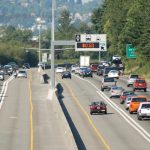Recommendations for Extending Asphalt Pavement Surface Life within Washington State
|
This study identified and evaluated hot mix asphalt (HMA) mix design and construction techniques that have potential for improving pavement surface life in Washington state. HMA pavement performance in Washington state varies across the state’s three broad climatic zones. In Western Washington, the average surface life of WSDOT pavements is 16.7 years. In Eastern Washington, the average surface life of WSDOT pavements is 10.9 years, and in the mountain passes, it is as low as 5 years. In addition, WSDOT pavements generally tend to fail first by cracking. However, rutting plays a more substantial role as traffic levels increase. The researchers evaluated and prioritized the application of 17 construction techniques to improve pavement life for Washington’s different climate zones and traffic conditions. ... Read More about Recommendations for Extending Asphalt Pavement Surface Life within Washington State | |





